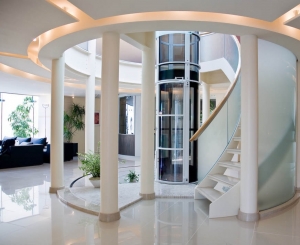The first elevator in Spain: how it changed vertical mobility
The first elevator in Spain was installed in the 19th century, marking a turning point in the country’s architectural and technological history. This innovation didn’t just revolutionize building design—it also redefined how people moved inside multi-level structures. From its debut in Barcelona to today’s smart lifts, elevators have evolved into essential tools for comfort, accessibility, and urban development.
When and where was Spain’s first elevator installed?
Spain’s first elevator was installed in Barcelona during the late 1800s. Designed and built by engineer Antonio Gallardo, the device was affectionately nicknamed “El Gran Ascensor”. It was installed in a landmark building and was one of the earliest vertical transportation systems available to the public in the country.
At a time when staircases dominated interior architecture, this new mechanism was seen as a marvel of modern engineering. Its success sparked growing interest across other Spanish cities, setting the stage for widespread adoption.
What impact did the elevator have on Spanish architecture?
The introduction of elevators in Spain had a profound impact on building design and city planning. With vertical mobility no longer a limitation, architects could:
-
Increase building height, leading to the rise of multi-story residential and commercial structures
-
Design with accessibility in mind, especially in dense urban areas
-
Allocate premium space to upper floors, making them more valuable and functional
The elevator became more than a convenience—it became a symbol of modernity and social progress. Over time, its presence shifted from luxury to necessity, particularly as cities like Madrid, Valencia, and Sevilla expanded.
Why did elevator use become so widespread?
As Spain’s cities grew, so did the demand for efficient, accessible vertical transportation. Key factors in the spread of elevators included:
-
Urban expansion: Taller buildings required reliable solutions for moving people and goods.
-
Population aging: With more elderly residents, accessibility became critical.
-
Building regulations: Over time, laws began to require elevator installation in certain types of buildings.
-
Increased awareness of disability rights: Elevators play a key role in enabling full participation in society for people with reduced mobility.
Today, elevators are installed not just in residential high-rises, but also in historical buildings, shopping centers, transport hubs, and public institutions—making them one of the most important components of modern infrastructure.
How has elevator technology evolved in Spain?
Since the first installation in the 19th century, elevator systems in Spain have undergone major transformations—technological, regulatory, and design-wise. The earliest models were hydraulic or pulley-based and required manual operation or steam power. Today’s elevators are automated, energy-efficient, and digitally connected.
Key milestones in their evolution include:
-
Introduction of electric motors (early 20th century), enabling faster and smoother rides
-
Adoption of automatic doors and floor selectors, enhancing safety and usability
-
Compact designs for installation in older or smaller buildings
-
Integration with home automation systems, especially in private residences and luxury developments
Spain now has tens of thousands of elevators in operation, and the country is home to several leading manufacturers and innovation hubs in elevator technology.

What are smart elevators and how do they work?
Smart elevators are the most recent innovation in vertical transport. These systems use remote monitoring, predictive maintenance, and user-specific features to improve performance, safety, and convenience.
Some key features include:
-
Mobile app connectivity: Users can call the elevator from their smartphone
-
Predictive diagnostics: Maintenance issues are identified before they cause failures
-
Energy optimization: Regenerative drives return energy to the building’s grid
-
Voice and screen-based interfaces: Elevators guide users with visual and audio feedback
-
Accessibility tools: Braille, auditory prompts, and adjustable timing for people with disabilities
In Spain, smart elevator systems are becoming increasingly common in hospitals, airports, office towers, and high-end residential buildings.
How do modern elevators support sustainability and accessibility?
Elevator technology today goes beyond transportation—it plays an active role in building sustainability and social inclusion.
Sustainability benefits:
-
Energy-saving features like standby modes and LED lighting
-
Regenerative braking systems that reduce electricity usage
-
Lightweight materials that require less power to operate
-
Fewer service calls thanks to remote diagnostics
Accessibility benefits:
-
Essential for people with reduced mobility
-
Crucial in public buildings for legal compliance
-
Helps aging populations stay in their homes longer
-
Contributes to universal design in architecture and urban planning
Installing or upgrading an elevator is one of the most impactful ways to make a building more inclusive, valuable, and future-ready.
Final thoughts: from “El Gran Ascensor” to modern smart lifts
The installation of Spain’s first elevator in Barcelona was more than a mechanical milestone—it marked the beginning of a new era in how we interact with buildings. What started as a luxury has become a daily necessity, transforming how we live, work, and access the spaces around us.
From the manual elevators of the 1800s to the smart, connected systems of today, Spain has embraced innovation in vertical mobility. And as accessibility and sustainability continue to shape the future of construction, elevators will remain at the heart of progress.
At Elevadores Vilber, we honor that legacy by delivering modern elevator solutions tailored to every building and user need. Want to learn more or upgrade your system? Contact us today for expert advice.





